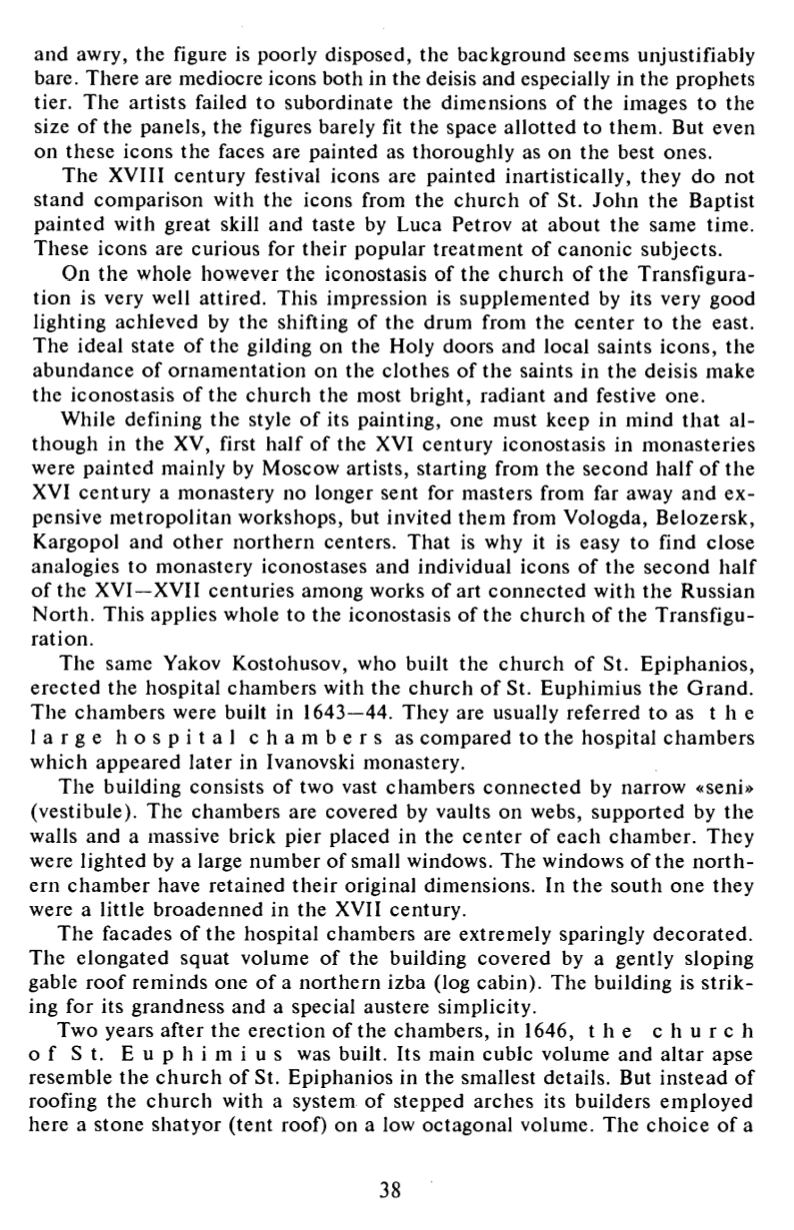

and awry, the figure is poorly disposed, the background seems unjustifiably
bare. There are mediocre icons both in the deisis and especially in the prophets
tier. The artists failed to subordinate the dimensions o f the images to the
size of the panels, the figures barely fit the space allotted to them. But even
on these icons the faces are painted as thoroughly as on the best ones.
The XVIII century festival icons are painted inartistically, they do not
stand comparison with the icons from the church of St. John the Baptist
painted with great skill and taste by Luca Petrov at about the same time.
These icons are curious for their popular treatment of canonic subjects.
On the whole however the iconostasis of the church o f the Transfigura
tion is very well attired. This impression is supplemented by its very good
lighting achieved by the shifting of the drum from the cen te r to the east.
The ideal state of the gilding on the Holy doors and local saints icons, the
abundance o f ornamen tation on the clothes of the saints in the deisis make
the iconostasis of the church the most bright, radiant and festive one.
While defining the style o f its painting, one must keep in mind th a t a l
though in the XV, first half of the XVI century iconostasis in monasteries
were painted mainly by Moscow artists, starting from the second half o f the
XVI century a monastery no longer sent for masters from far away and ex
pensive metropolitan workshops, but invited them from Vologda, Belozersk,
Kargopol and o ther northern centers. That is why it is easy to find close
analogies to monastery iconostases and individual icons of the second half
o f the XVI—XVII centuries among works of art connected with the Russian
North . This applies whole to the iconostasis of the church o f the Transfigu
ration.
The same Yakov Kostohusov, who built the church o f St. Ep iphanios,
erected the hospital chambers with the church o f St. Euphimius the Grand.
The chambers were built in 1643—44. They are usually referred to as t h e
l a r g e h o s p i t a l c h a m b e r s as compared to the hospital chambers
wh ich appeared later in Ivanovski monastery.
The building consists of two vast chambers connected by narrow «seni»
(vestibule). The chambers are covered by vaults on webs, supported by the
walls and a massive brick pier placed in the cen ter of each chamber. They
were lighted by a large number of small windows. The windows o f the n o r t h
ern chambe r have retained their original dimensions. In the south one they
were a little broadenned in the XVII century.
The facades o f the hospital chambers are extremely sparingly decorated.
The elongated squat volume of the building covered by a gently sloping
gable roo f reminds one o f a northern izba (log cabin). The building is s trik
ing for its grandness and a special austere simplicity.
Two years after the erection of the chambers, in 1646, t h e c h u r c h
o f St . E u p h i m i u s was built. Its main cubic volume and altar apse
resemble the chu rch o f St. Epiphanios in the smallest details. But instead of
roofing the chu rch with a system of stepped arches its builders employed
here a stone shatyor (tent roof) on a low octagonal volume. The cho ice o f a
38















